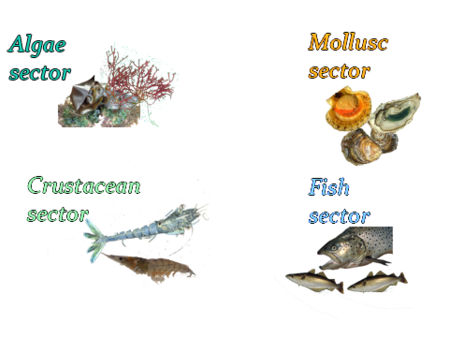Fishmeal and other aquatic products
Fishmeal manufacture was originally a means of exploiting surpluses from fisheries for human consumption. As interest in this product grew, however, specialised “industrial” fishing began to supply the demand.
Aquaculture fact sheet - March 2008
http://en.aquaculture.ifremer.fr/Info.-Card
Origin and production
The principal countries producing fishmeal are those in northern Europe – United Kingdom, Denmark, Norway and Iceland – and the west coast of South America – Peru and Chile.
In Europe, six main species of small pelagic fish are used to make fish oil and fishmeal: sandeel, Norway pout, sprat, capelin, blue whiting and herring .
- The first five of these species are little sought for direct human consumption: less than 10 % of the first species fished and 25 % of blue whiting catches are consumed in this way.
- The herring used for fishmeal comes from excesses of TAC (Total Allowable Catch) or fisheries discards.
- Mackerel, anchovy and horse mackerel are also used in fishmeal production.
In addition, a third of all fishmeal produced comes from treating waste or by-products from the food processing industry (Spain, Germany, France, United Kingdom and Iceland).
In Peru, the anchovy is by far the main species for fishmeal production, followed by the jack mackerel. In Chile, the industry uses the anchovy, jack mackerel, horse mackerel and sardine (FIN, 2006; Data UK, 2005)
Countries | 2004 | 2005 | 2006 |
|---|---|---|---|
Peru | 1 983 000 | 2 126 000 | 1 456 000 |
Chile | 935 000 | 815 000 | 776 000 |
Denmark | 259 000 | 222 000 | 213 000 |
Norway | 212 000 | 154 000 | 176 000 |
Iceland | 204 000 | 179 000 | 162 000 |
Total of five countries | 3 593 000 | 3 496 000 | 2 283 000 |
World total | 5 719 000 |
Almost 60% of this production is exported.
Manufacture
Several similar methods are used for the fishmeal production process. These differ in whether there is a cooking step before the drying step and in what temperature used for these two steps.
Direct drying produces white fishmeal (used on whole fish, partially emptied fish and waste left over after the removal of filets; fat content 3 - 6 %).
Drying after cooking (used on whole fish from which the oil has been extracted by cooking), produces a darker meal.
Temperature is an important parameter for the quality of a meal (protein digestibility). LT (low temperature: 70°C) meals are available on the market. Their maximum humidity is fixed at 10 % to ensure their stability.
The processing of lean fish gives a whole meal whereas oily fish also give oil and fish solubles.
Fishmeal composition
Fishmeal protein content depends on which parts of the fish are used to make it, it can vary between 58 and 70 % according to the type of meal: type 62 (58 to 63 %); 65 (63 to 68 %); 70 (68 to 70 %).
Fishmeal quality also concerns digestibility of Nitrogen (dN 88 to 90 %) and Phosphorus (dP 38 to 51 % - Sauvant et al., 2004).
Elementary composition of soluble fish protein concentrate (SFPC)
Soluble fish 'protein' concentrate is obtained by grinding, enzymatic hydrolysing, filtrating, concentrating and deshydrating fresh fisch (whole fish or wastes of fish threading). It contains peptids and aminoacids which give to it a great solubility and a high digestibility of nitrogen (digestible Nitrogen 95 %).
Elementary composition of soluble concentrate (crude produce) | Lean : | Fat: |
|---|---|---|
Crude protein | 80 % | 72.5 % |
"Hydrolysis" fats | 4.7 % | 21.2 % |
Uses
Fishmeal is used as feed for livestock both in terrestrial (pigs, poultry, etc.) and marine systems and there is strong competition between these sectors: 43 % of meal is used for terrestrial livestock, 57 % for fish and crustaceans.
In aquaculture, fishmeal is used as feed for a large array of carnivorous and omnivorous species. Shrimp, marine fish and salmonids are the principal consumers. As for fish oil, aquaculture consumes 87 %, of which half is used for salmonids.
Commercial value of fish meal
The market value of fishmeal is not only based on its protein content but is related to demand, supply and competition with other protein sources.
The recent increase in the price of fishmeal is due to the high demand from China and other countries in Asia.
Present situation and Prospects
On the worldwide scale, most wild-capture fisheries have almost reached their limits of sustainable exploitation, if they have not already surpassed them.
Aquaculture is the fastest growing sector in animal-based food production, with an annual growth rate of 8.8 % since 1970, compared with only 1.2 % for capture fisheries and 2.8 % for terrestrial animal production systems during the same period.
Faced with the growing demands from aquaculture and the foreseeable stagnation of fish meal and oil production from fisheries, it appears necessary to reduce the proportion of fish meal in the feeds used in aquacultural rearing.
The research for alternative feeds of vegetable origin has been going on for several years.
Strong points | Weak points |
|---|---|
|
|
** As a precaution, no reared species of fish is used to produce meal intended to feed the same species.

